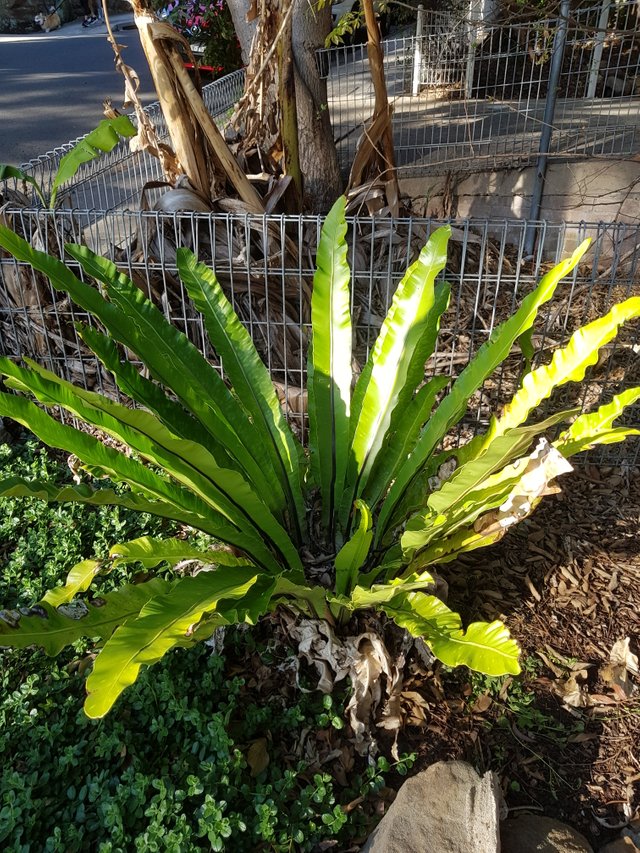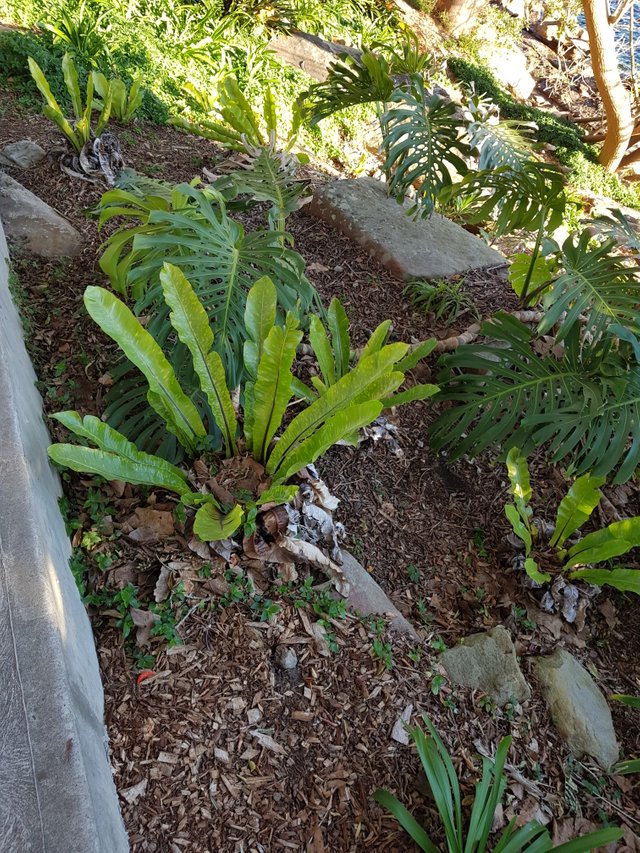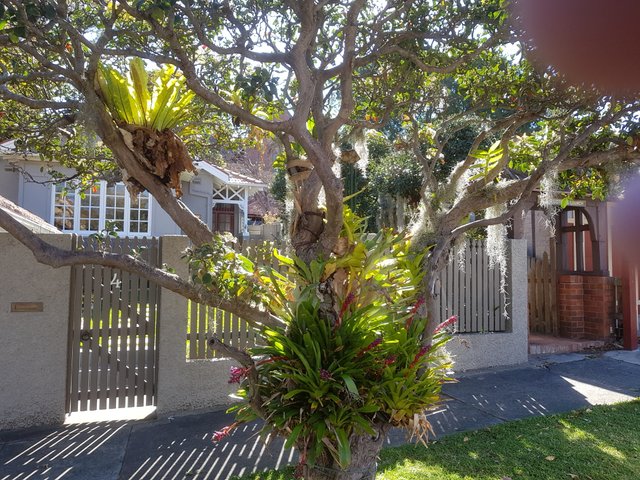Birds Nest Fern - not just for the empty-nesters.
The Birds Nest Fern is native to several warmer climate countries including Australia. It's Botanical name is Asplenium nidus, and there are several species including one with forked fronds. This plant is an Epiphyte in it's natural habitat, meaning that spores ( like small seeds ) lodge and germinate in places like the forks of trees that offer good support, where they grow, and the rosette of fronds collect falling leaves, birds droppings, dead insects etc and these provide nutrients for the plant. Natural rainfall provides water and helps decay the leaves that the plant collects. Birds Nest Ferns also grow happily in garden soil as long as it is kept moist ,shaded from the hot sun and preferably high humidity. Young plants will grow in suitable spots by themselves.
Birds Nest Ferns are suitable for pots and can be grown indoors or outdoors where they add a tropical feel to a garden. Allow a bit of space for this plant, as they grow quite large, having fronds up to 2 metres long. They are best suited to cool temperate, temperate and warmer climates and are common around Sydney gardens, where i took these photos.


@ctrl-alt-nwo, The Birds Nest Fern already in my home garden.
The bird’s nest fern plant gets its name from the fact that the center of the plant resembles a bird’s nest. It is also occasionally called a crow’s nest fern. Bird’s nest ferns (Asplenium nidus) are identified by their flat, wavy or crinkly fronds. Their appearance can bring to mind a seaweed plant growing on dry land. Bird’s nest fern is an epiphytic fern, which means in the wild it typically grows on other things, like tree trunks or buildings. When you buy it as a houseplant, it will be planted in a container, but it can be affixed to planks and hung on a wall much like staghorn ferns.
Bird’s nest ferns grow best in medium to low indirect light. These ferns are often grown for their crinkly leaves and the light they receive will affect how crinkled the leaves are. A bird’s nest fern that receives more light, for example, will have more crinkled leaves, while one that receives less light will have flatter leaves. Keep in mind that too much light or direct light will cause the fronds on bird’s nest fern to yellow and die.
Source: https://www.gardeningknowhow.com/houseplants/birds-nest-fern/birds-nest-fern-care.htm
Fav. comment Award ! Great Pics, thanks.
The Bird's nest differs from many in appearance because of it's spear like shaped leaves rather than feather or palm like fronds. The leaves (have a brown mid-rib and wavy margin) grow up to about 2ft long from a rosette of fronds where new leaves appear when the plant is producing new growth.
While a plant is young and small it can be placed anywhere in a home or office with the correct conditions provided (light, etc.). Once it matures though, you'll need to provide enough space for the rosette of fronds to spread out over 2ft each side. A conservatory is best suited or a fairly large room once it does mature.
https://www.houseplantsexpert.com/birds-nest-fern.html
Silly Sausage Award ! Thanks for your good choice of Pics.
The Bird's Nest Fern or Asplenium nidus is one of the several popular and beautiful ferns grown as houseplants. The Bird's Nest Fern is easy to care for and suits many homes making it a versatile houseplantFerns like this one can be grown in North facing windows perfectly well and will truly relish the type of light and cooler temperatures these places receive.
In return the Bird's Nest Fern will give you lots of naturally glossy leaves arranged in a circular pattern which resemble a bird's nest (hence the common name for these houseplants).
https://www.ourhouseplants.com/plants/bird-nest-fern
While this fern finds it home in the humid tropics, it can be found growing in and around trees. This may seem a little odd but there is a reason for this relationship. First, the tree provides additional humidity and two, it provides shade.
To successfully grow this fern indoor, we must first replicate the two conditions described above.
The first thing we need to consider is the light requirement of this plant. Light can be tricky when it comes to the Bird’s Nest Fern. The best type of sunlight for this plant is bright light without direct sunlight. If the plant receives too much sunlight, the fronds will become light green or will have burn marks. Having said that, there really nothing wrong with letting the plant have a little early morning or pre-sunset light.
http://www.weekendgardener.net/houseplant-care/how.to.care.for.and.grow.a.birds.nest.fern.htm
I love reading your posts as they giving me great ideas , i thinking when will be the best time to do it on my own as the winter is coming
Shared on twitter promoting good quality content on #Steemit.
#Promo-Steem #steemtalent #JoinSteemit #Steemit
Birds Nest Fern - not just for the empty-nesters. #steemtalent #JoinSteemit #Steemit @Steemit
#Gardening #GardenersWorld
#Plants #Photography #Photographer #Blogger #Blog #Australia
https://twitter.com/StephenPKendal/status/1051500372718706688
Beautiful plant my friend and epiphytic, rosette-shaped fern with sword-like, undivided fronds growing from a central region. Fronds are smooth-textured, glossy, light green with a dark brown/black midrib, 60 to 120cms long and 7 to 20cms wide. In natural conditions this fern can be seen high up in crooks of trees but is generally planted at ground level, beneath a canopy of trees or tree ferns, preferring filtered light, to light shade. Grows well alongside Orchids and Bromeliads. Likes a loose, enriched, organic soil mix, kept as moist and humid as possible. Do not expose to direct sun, other than early morning sun and avoid frost prone zones and coastal exposure. In the growing season can be fertilised twice weekly with a liquid fertiliser but do not apply to centre of rosette.
SPECIFICATIONS
Dimensions Height: 0.6 to 1m, Width: 1.5m
Aspect Part shade
Origin Eastern Australia, tropical south east Asia
Pests & diseases Snails and slugs in garden situations and Mealy Bug on indoor plants.
Typical sizes 140mm, 200mm, 300mm
Thank you @ctrl-alt-nwo
A source of information: https://www.alpinenurseries.com.au/plant-library/asplenium-nidus/
Amazing plant @ctrl-alt-nwo! Commonly known as a bird’s nest fern, Asplenium nidus has many names. For instance, in Malaysia it is called: Rumah Langsuyar, in the Philippines: Pakpak-lauin and in China: Tai wan shan su hua. There are also many synonyms for this fern, which include Asplenium ficifolium, Asplenium antiquum, Neottopteris mauritiana, Neottopteris nidus. It belongs to the Plantae Kingdom , Pteridophyta phylum, Polypodiopsida class, Polypodiales order, the Aspleniaceae family, Asplenium genus.
Geographical distribution:
This fern is a native of tropical Africa , Australia and tropical Asia. Asplenium nidus either grow terrestrially on the ground, or epiphytically on the trees. Sometimes they grow on rocks (Piggott, 1988).
The sword-shaped fronds grow from the centre of the plant to form an inverted cone. The fronds are very long approximately 50-120cm, and 10-20cm wide, also the leaves or fronds are light green, often crinkled, with a smooth-edged blade and a black midrib that is obvious. The sporangia develop in clusters called sori, covered by an elongated indusium on the back of the fronds. It has roots for absorption of water and minerals from the soil (Koh, 2009). In terms of size this alters according to the habitat (Piggott, 1988).
A source: https://blogs.reading.ac.uk/tropical-biodiversity/2014/01/asplenium-nidus-2/
Aha! I have this fern in my garden, my friend gave it to me three years ago. Now they are quite big! I wish I could eat their leaves! So green and crunchy!
Posted using Partiko iOS
Have seen them and yeah they do look pretty nice as well. While recently I was able to get few images and most of them were about different kind of leaves, well this kind of reminded me of those images .